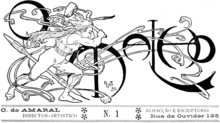O Malho
O Malho (Portuguese: The Mallet) was a Brazilian weekly satirical magazine published from 1902 to 1954. It was based in Rio de Janeiro, Brazil. It was the first commercially successful Brazilian satirical magazine during the Republican regime.[1]
 Logo of O Malho in the first issue | |
| Categories |
|
|---|---|
| Frequency | Weekly |
| Founder |
|
| Founded | 1902 |
| First issue | 20 September 1902 |
| Final issue | January 1954 |
| Country | Brazil |
| Based in | Rio de Janeiro |
| Language | Portuguese |
| OCLC | 19233235 |
History and profile
O Malho was established in 1902[2] and the first issue was published on 20 September 1902.[3][4] Its founders were Luis Bartholomeu Antonio Agnello de Souza e Silva, a member of the Brazilian Parliament and Antonio Azeredo, a senator.[1] The magazine was headquartered in Rio de Janeiro and was published on a weekly basis.[3] Although the magazine targeted men and women from different social classes,[5] it basically targeted the working-class readers.[1] During the initial years French artist Crispino do Amaral was the main caricaturist of the magazine.[4] Antonio Leal served as the photographer of the magazine.[6] The publisher of the magazine, O Malho Group, also published a children's and comics magazine, O Tico Tico.[7]
O Malho was the first Brazilian magazine with color pages.[8] The magazine focused on humor and political satire.[9] It contained caricatures and other satirical materials.[1] The magazine also featured musical scores by composers, poems and chronicles.[3] From its start in 1902 to 1926 the magazine regularly featured piano music-related articles in two pages.[5] The work by Elda Coelho on music was covered in the magazine.[5]
Sabino Barroso, president of the Chamber of Deputies, resigned from office due to satirical publications about him in the magazine.[2][4] In March 1906 O Malho sold 40,000 copies.[1] It folded in January 1954.[2][3][4]
References
- Felipe Botelho Correa (January 2012). "The Readership of Caricatures in the Brazilian Belle Époque: the Case of the Illustrated Magazine Careta (1908-1922)". Patrimônio e Memória. 8 (1).
- Rodolfo Espinoza (June 1999). "Brazil Culture". Brazzil. Retrieved 18 February 2017.
- Eric Lana (1 April 2011). "Partituras de O Malho e Seu Leitor-Modelo" (in Portuguese). Academia. Retrieved 18 February 2017.
- "Malho, O" (PDF). O Centro de Pesquisa e Documentação de História Contemporânea do Brasil (in Portuguese). Retrieved 18 February 2017.
- Tom Moore (1 September 2000). "A Visit to Pianopolis: Brazilian Music for Piano at the Bibliatica Alberto Nepomuceno". Notes. Retrieved 18 February 2017.
- Randal Johnson (1987). The Film Industry in Brazil: Culture and the State. Pittsburgh, PA: University of Pittsburgh Press. p. 28. ISBN 978-0-8229-7644-8.
- "Comics: the early editorial market in Brazil (Daniel Serravalle de Sá 2008)". Studies in Fiction. 24 August 2009. Retrieved 18 February 2017.
- "Serialized Publications". Bibliotica Nacional. Retrieved 18 February 2017.
- James N. Green (2001). "Challenging National Heroes and Myths: Male Homosexuality and Brazilian History". Estudios Interdisciplinarios de América Latina y el Caribe. 12 (1).
External links
 Media related to O Malho at Wikimedia Commons
Media related to O Malho at Wikimedia Commons- O Malho in the Digital Collections of the Ibero-American Institute